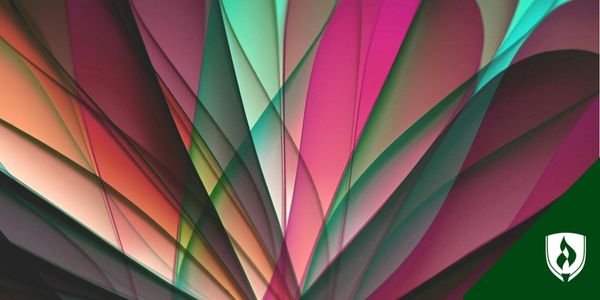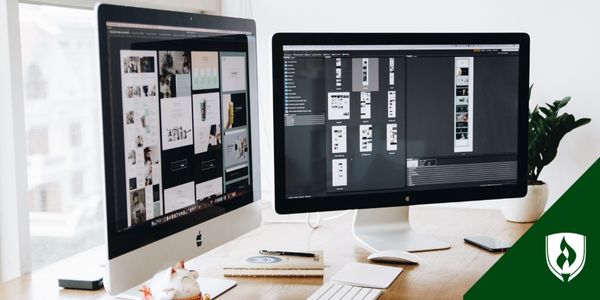What Can You Do with a Graphic Design Degree? Exploring Your Options
By Brianna Flavin on 05/11/2023

The road to career success looks different for everyone. After some thought, you're starting to consider a graphic design career path. But before you commit the time and money it takes to acquire the formal training many employers require, you want a better idea of what the potential job prospects will look like after graduation.
So what can you do with a graphic design degree, anyway?
Many people think there's just a single answer—become a graphic designer. But the options are much more varied than that.
“One of the beautiful aspects of studying graphic design is the wide variety of jobs one can pursue after receiving a graphic design degree,” says graphic designer and art director Amy Lewin. “I never wanted to be too specialized in my career. I crave variety in design and love switching up my style and working on a range of projects.”
Graphic design education will train you in useful skills for a variety of creative careers as well as a career in graphic design. Take a minute to learn a bit more about what Graphic Design majors learn and you'll see what we mean.
What do you learn in a graphic design program?
Motion graphics, animation, design theory, project management and portfolio development are some of the main learning objectives in Rasmussen University's Graphic Design program. Courses like the Business of Digital Media, Interactive Publishing and Digital Effects teach a broad base of knowledge that would be useful all across business and marketing fields as well as graphic design careers.
Advanced Typography and Advanced 3D Modeling are examples of specialized courses that provide more specific skills valued in the industry. Overall, students in these programs work to master technical design skills as well as useful project management and general business knowledge.
“I remember I learned a bit of [Adobe] Flash in design school, because I wanted to broaden my skill set,” says Gabe Ruane, co-founder of Turn Agency. “I also picked up basic animation skills and found myself more marketable because I had a bit more than the baseline graphic design education.” Ruane says the digital aspects of graphic design education are extremely important.
“Everything happens on screens,” Ruane says. “I'd like to think most graphic design programs these days focus time and energy on the digital side of design.” While being a generalist in this sense can be super versatile in many careers, students who prefer to focus in on a special area can also make use of that passion.
“If you see yourself enjoying a niche area of design in branding, package design, environmental design, UI/UX, web design, textiles, illustration or photography, etc., then go for it!” Lewin says. She advises students to pursue what they actually want to be doing on the job. For example, it took Lewin some time and experience to realize she wasn't interested in UI/UX or web design and didn't need to scramble to learn additional coding skills.
If you don't see yourself specializing in one area, Lewin suggests remaining open to all types of graphic design jobs to get experience and learn more about what you like and what you'd rather not spend your time on. The industry is versatile enough to give you plenty of choices.
10 Popular careers in graphic design
But what are some of those choices specifically? We used real-time job analysis software to examine over 30,000 job postings seeking graduates of Graphic Design programs.1 This is definitely not a comprehensive list of what you can do with a Graphic Design degree—only a representation of graphic design degree jobs out there.
1. Graphic designer
Graphic designers develop graphics and layouts for product illustrations, company logos, websites and more. This job title can cover a huge range of duties in a huge range of industries. Graphic designers work in almost every major industry since companies need their skills on everything from brand identity to packaging--everything from a clear flyer to a great logo.
You'd be hard-pressed to make it through a day in our world without seeing something these artists designed.
So what does that look like in practice? Ruane worked as a graphic designer at a technology magazine, creating magazine layouts, some advertising, print production and a bit of web design.
Lewin worked as a senior graphic designer at a video game publishing company, designing and art directing video game titles. “I worked on everything from designing the campaign art used on packaging to concepting and art directing the ‘Just Dance 2019' commercial.”
Read more about in-demand animation skills you might use if you're in graphic design.
2. Creative director
Creative directors determine the creative vision of a project. They make sure the overall aesthetic and cohesive look stays on track by leading their team through the steps to create something, whether that is a tangible product like a video game, film, magazine or something more abstract like an advertising campaign or brand identity.
The job involves managing skills, leadership and often budgeting and time management abilities as well as creative vision.
When Ruane worked as an associate creative director at a digital ad agency, his work involved concepting with a copywriter partner, pitching and presenting ideas and leading a team of designers and art directors while still taking part in the visual design.
3. User experience (UX) designer
UX designers work to make products, processes and services seamless, enjoyable and intuitive for users. They think about how the product feels, how users will use it. They ensure the product flows from one step to the next. UX designers might run user tests, refining any bumps or confusions in the process.
This career involves tons of out-of-the-box thinking, creative intuition and a natural appreciation for smooth design. This design discipline is often found in web design, where organizations are placing an increased emphasis on ensuring their website designs are both visually appealing and simple to use.
When the actual job title of UX designer started becoming more popular, Ruane saw many of his fellow graphic design classmates transition into UX careers. This is an excellent role for technology-savvy designers as it often requires a blend of design and web technology skills
4. User interface (UI) designer
Think of UI design as a subset of UX design with similar overall goals. User interface designers focus on product layout. They design each screen and each page, making the flow of each progression visually clear in tandem with the overall path a UX designer charts.
UI designers might make calls on different design elements, choose the location for content on an analytics dashboard or pick the tools users need to navigate a page. They also pay close attention to style coherence and ensure the product remains consistent.
5. Production artist
Production artists take over the hands-on steps of production—whether that's in graphics, film, art or other formats. They upload and ensure the accuracy of design files throughout the last stages of development. The job is equal parts design and computer applications skill.
Production artists might suggest improvements to the work they are finishing as well as making final touches like scaling, cropping, retouching and repositioning.
“If you start as a junior designer at an agency, or as a production artist, you'll get to work alongside a dozen people in strategy, technology, development, animation, data, UX, analytics and more,” Ruane says.
He emphasizes that positions like this can really help you get exposure to the variety of jobs out there. You might find that you really enjoy a particular part of the process. “Or if you stick with pure visual design, you'll be a stronger designer for having worked alongside these related specialists.”
6. Product developer
Product developers ideate, lead and manage the creation of products. They can work on so many different things that their job duties will vary widely, but general tasks include performing industry research, creating illustrations, presenting the product to employers or stakeholders and contributing to the development process.
This role might go hand in hand with graphic design. “It's my favorite because the role is varied, allowing me to work across various departments and on several different tasks,” says Damien Cunningham, product developer and senior graphic designer at Find Me a Gift. “I could be creating digital marketing material one day and then producing packaging for print or designing a new product another.”
7. Art director
Art directors take charge of the visual style and content in magazines, newspapers, product packaging and movie and television productions. They create designs of their own and also direct other artists. They oversee designers and other creative professionals and hire for graphic design positions. They work closely with their employers or clients to cast an artistic vision that meets objectives, the available budget and desired impact.
These positions are great advancement options for graphic designers. Working as an art director means increased responsibility--building a company's visual presence and overseeing all the materials. Ruane says his time working as an art director was a real highlight in his career. “It was so exciting and inspiring! Big brands, high-profile work, lots of energy and, as it turned out, a great networking frenzy that led to relationships I now rely on for my own agency business.”
8. Marketing specialist
Marketing specialists collect and analyze data on target customers, initiate marketing campaigns, measure effectiveness of marketing attempts and create strategies to promote their company and its goods or services.
As you've probably noticed, many of these graphic design careers fall under the larger umbrella of marketing. Cunningham says graphic designers should consider more job titles in the marketing category with their expertise. Your knowledge of color theory, visual elements, consumer behavior and creative thinking can be a huge asset in campaigns.
“A marketing career allows designers to apply their skills to a huge assortment of tasks like digital and print graphics, branding and social media. This keeps things exciting and also offers many options for future careers," Cunningham says. These roles require some of the same skills earning a degree in graphic design requires--great communication and project management, plus the drive the learn more and build skills.
9. Multimedia artist or animator
Multimedia artists and animators design complex graphics and animation using computer animation or modeling programs. They think about story development, visual impact and platforms to create media content that will meet their employer's objectives. More brands and organizations are looking to increase their online video presence—and that's been a boon for graphic designers with animation and motion graphics skills.
10. Freelancer
While it's not technically a design job title, plenty of designers work on a freelance basis. Designers who have some experience on their resume, a stunning portfolio of work or expertise in niche areas of design, marketing and graphics could build a career out of freelance projects.
But freelancing is also excellent as a side-gig that can bring in some extra cash—and boost your expertise. Ruane says he worked on side projects with small clients throughout his career on a huge range of project types. “There's lots of ‘figure-it-out-as-you-go' in freelancing, and the continuing education is hugely beneficial,” Ruane says.
A graphic designer specializing in a certain area of design can also build up a clientele that could turn into something more long-term. Ruane's freelance experience eventually led to his own design agency. Designers who spend time freelancing will likely learn valuable communication skills and how to balance multiple projects at once.
Freelancing can also help you push your creative skills into directions you might not typically try. And it's a great way to build up your professional portfolio. Check out our article "Exploring the Pros & Cons of Being a Freelance Graphic Designer".
Start on your graphic design career path
Graphic design is so profoundly versatile that your imagination can take it almost anywhere. “As an undergrad, I never would have imagined my trajectory would provide me with so many opportunities,” Lewin says. “I've worked on package designs for video game titles, branding projects for small businesses, print collateral for pharmaceutical companies, online and retail marketing advertisements, organized photoshoots and art directed TV commercials.”
Lewin's biggest piece of advice for aspiring designers is to never settle in a role if you are unhappy. There is more out there, so keep trying and keep looking for what inspires you!
“You can take your graphic design foundation and apply it to any creative project, on any platform, using any media or technology,” Ruane says. “The principles of design are always top of mind, and the educational background can serve you well in any number of specialties.”
So does a career in graphic design sound like what you're looking for? Graphic design students in a program gain industry awareness as well as useful skills and background knowledge. If you pursue a degree in graphic design, you might discover roles you've never heard of. Graphic designers can find all sorts of opportunities unique to their interests or their preferred type of employer.
Imagine what an education in graphic design could open up for you. Learn more about your learning options by visiting the Rasmussen University Graphic Design degree page.
Related Articles:
- How to Become a Graphic Designer: Career Advice from Creative Pros
- What Is a Production Artist? The Experts in Creative Execution
- What Does an Art Director Do? Expert Insight from the Pros Who Know
11Burning-Glass.com (analysis of 33,170 graphic design degree job postings, Apr. 01, 2019 - Mar. 31, 2020).
Adobe Flash is a registered trademark of Adobe, Inc.
This article was originally published in September 2014. It has since been updated to include information relevant to 2023. Insight from sources remains from original article.




